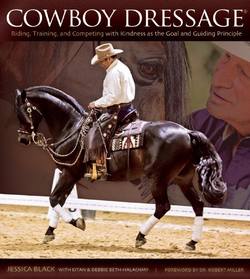Читать книгу Cowboy Dressage - Jessica Black - Страница 21
На сайте Литреса книга снята с продажи.
Zeitgeist
ОглавлениеCowboy Dressage has remained true to the idea of rider and trainer as artist, but it has also evolved. Deb and Eitan’s willingness to move with the times has been part of the new discipline’s success. In the horse world—any horse world—it is easy to ignore the news. Horses do not care, and horsey friends tend to be beyond politics. Horse people are so happy to find others whose eyes don’t glaze over at the mention of gaits or tack, or the latest training methods, that they are willing to overlook all sorts of things that tend to polarize other people.
2.3 – This beautiful Friesian stallion is called Knight Invader or “Vader.” Every horseperson has a list of names she is waiting to bestow on the perfectly matched horse. Maybe that horse is a delicate chestnut mare, a rugged grey gelding, or a magnificent black stallion with long rippling mane. Near the top of my list is Zeitgeist, in German, literally “time spirit” or spirit of the age: the dominating social and cultural current of an epoch. If I ever get that horse, he will have to do Cowboy Dressage, a discipline that so ably captures the spirit of our time.
Sometimes they also ignore new ideas that bring people together, define the current social environment, and have the potential to contribute to their relationship with horses and other horse people. What makes Cowboy Dressage so appealing is Eitan’s attentiveness to what is going on in the world outside the arena. Cowboy Dressage is successful because it adapts to and fits within the paradigm outside the world of horses.
The philosopher Hegel believed that people could not escape the Zeitgeist, or the prevailing social and cultural customs. We are the spirit of our time, because as members of society, we shape it and are shaped by it according to what is meaningful (Redding, 2010).
2.4 – “No man can surpass his own time, for the spirit of his time is also his own spirit.” (Hegel)
Talking with Eitan can be a strong reminder of where we stand in history. We know from academic research, for example, that corporal punishment does not work with children. That does not mean spankings never happen, and it does not mean that anyone has found an alternative that does work, but we do know that we ought to avoid physical punishment as means to ensuring good behavior. The same goes for a horse—it is not that there will never be a time when a whip is necessary; for starters, whips and spurs are used to enhance the precision of rider cues. There will be times when the trainer needs to be determined to establish her alpha status with a sharp word or touch of the whip. But no-one, horse or person, learns effectively when the teaching method relies on pain or punishment. Thus the central tenet of Cowboy Dressage: Be kind to your horse (fig. 2.5).
2.5 – Jessi Morrill pets her horse To the Maxx at a Cowboy Dressage show. Kindness is rewarded directly in Cowboy Dressage competition through points awarded for Soft Feel, Harmony, and Partnership.
Similarly, the emphasis on negotiating a relationship that pervades today’s culture (one negotiates with children, spouse, pets…) is reflected in the give-and-take with the horse in Cowboy Dressage. We know that the best way to get results is not to demand, but to negotiate. The relationship between horse and rider is a partnership; the rider, in training her horse to listen, must listen even more carefully to her horse. This sensitivity to the needs of the horse is part of Soft Feel, the guiding principle of Cowboy Dressage. The constant communication between horse and rider is the foundation for training in the Cowboy Dressage fashion.
